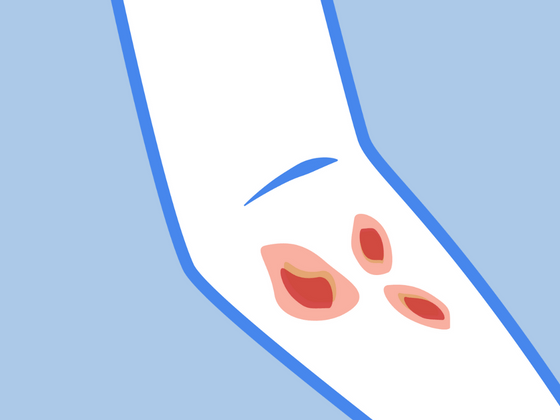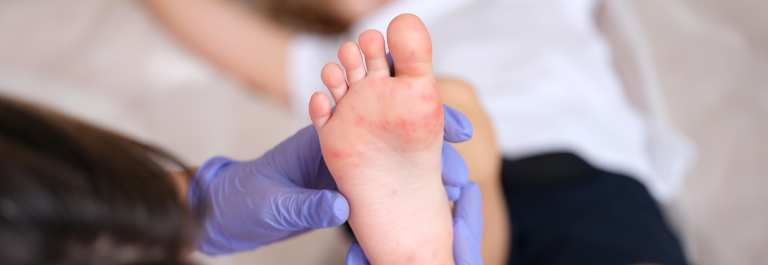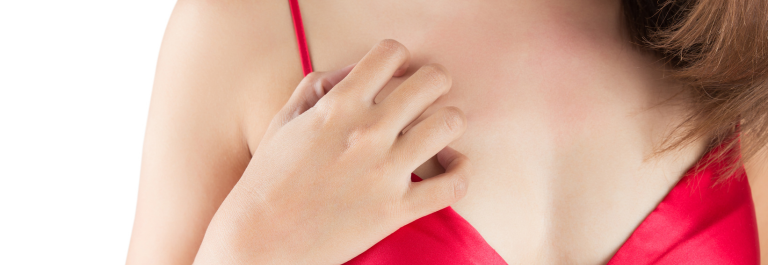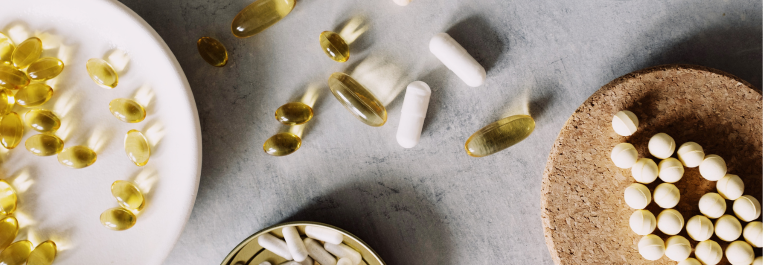Do you suffer from itchy blisters on your hands and the soles of your feet? You could be experiencing dyshidrotic eczema, a common skin condition characterized by painful blisters on the fingers, soles of the feet, and palms of the hands.
In this blog, we will cover everything you need to know about:
-
The symptoms of dyshidrotic eczema
-
What can trigger dyshidrotic eczema flares
-
How to treat and help relieve symptoms
Read on to learn more about what causes dyshidrotic eczema on the hands and feet, how to manage the uncomfortable symptoms, and how to restore your skin to total health.
What is Dyshidrotic Eczema?
Dyshidrotic eczema, sometimes known as dyshidrosis, palmoplantar eczema, vesicular eczema, pompholyx, or foot-and-hand eczema, most commonly affects women between the ages of 20 and 40. This type of eczema tends to be more common in those with a personal or family history of contact, atopic dermatitis, or another form of eczema.
The Symptoms of Dyshidrotic Eczema
-
Small blisters on the sides of the fingers, hands, and feet (typically one to two millimeters in diameter)
-
Itchy, scaly patches of skin surrounding the blisters
-
Increased sweat around the blisters
-
Prickling sensation in the hands and feet
-
Heat in the hands and feet
-
Swelling and changes to the skin around the nail
With dyshidrotic eczema, you may notice a burning or itching sensation in your hands and feet before you notice blisters. Without proper treatment, dyshidrotic eczema can develop into pus-filled blisters that can get bigger and spread to the backs of your hands, fingers, and feet. In severe cases, these large blisters can develop a secondary bacterial infection.
What Triggers Dyshidrotic Eczema?
Dyshidrotic eczema is usually triggered by allergies or exposure to a particular substance, most commonly cement or certain metals like cobalt or nickel. This type of allergic reaction is called contact dermatitis. It occurs when the immune system mistakenly believes it is under attack from a minor irritant or allergen and overreacts by releasing histamine, the chemical known to cause itchy rashes!
Having frequently moist or sweaty hands and feet is another leading factor in the development of dyshidrotic eczema flares. Although sweat is known to be a common trigger, experts are still unsure why.
Other triggers for dyshidrotic eczema include food allergies, seasonal allergies or hay fever, stress, and certain medications like birth control or aspirin.
Treatment for Dyshidrotic Eczema
Your healthcare provider may use allergy testing, patch testing, or blood tests to diagnose dyshidrotic eczema. Although antibiotics and stronger prescription medications may be necessary to treat more severe cases, there are a number of different treatment options available to help you manage this uncomfortable skin condition and get your skin back to health!
How to Wash the Affected Area
When washing your hands and feet during a dyshidrotic eczema flare, it is important to use lukewarm water instead of cold or hot and to dry your hands and feet thoroughly after bathing or swimming. It is recommended that you wash the affected areas gently with a mild, scent-free soap to avoid a secondary skin infection.
We recommend our scent-free Grass Fed Tallow Soap, which is excellent for sensitive and allergy-prone skin. With all-natural, moisturizing ingredients, this soap is guaranteed to soothe symptoms of various skin conditions, from atopic dermatitis to dyshidrosis.
Applying cool compresses to the blisters and soaking your hands and feet in cool water should also help relieve some of the itching and irritation. It is also important that you wear gloves when your hands come into contact with detergents or other potential triggers in your daily life if you are suffering from dyshidrotic eczema. If your hands and feet come into contact with a potential trigger, you should wash and then moisturize them immediately.
The Best Natural Moisturizers
After bathing, apply a strong emollient cream to the affected area while your skin is damp to ensure the moisture is locked in. We recommend the Organic Manuka Skin Soothing Cream as it can moisturize even the driest of skin! This manuka honey moisturizer is non-greasy and will not burn or sting the skin. Instead, it helps to repair the skin barrier and is packed full of antibacterial power, making it the perfect choice for you during your painful dyshidrotic eczema flare!
We understand that dyshidrotic eczema on your hands can make daily life difficult; using protective clothing alongside an effective moisturizer should also help your blisters heal and relieve itching and inflammation.
We recommend our Remedywear™ (TENCEL + Zinc) Gloves to help soothe and protect your skin as it heals. Embedded with anti-inflammatory zinc, these gloves are form-fitting, breathable, and moisture-wicking, providing much-needed relief from the symptoms of dyshidrotic eczema on the fingers and hands.
Diet
Nickel and cobalt are two metals known to trigger dyshidrotic eczema; however, both are natural elements found in many foods. Cobalt can be found in vitamin B12, dairy products, shellfish, poultry, and meat, and nickel can be found in cereals, tea, legumes, soy products, and dried fruit.
If your doctor suspects your dyshidrotic eczema flares are caused by a nickel or cobalt allergy, they may suggest an elimination diet to limit the cobalt and nickel intake through your diet.
Other Useful Treatment Tips
-
Remove rings and other jewelry when you wash your hands so water doesn't linger on your skin.
-
Keep your fingernails short to help prevent scratching from breaking the skin, which could lead to an infection.
-
Light therapy using ultraviolet light can be helpful to clear up some skin conditions and prevent dyshidrotic eczema.
-
It may be tempting to pop your blisters yourself, but this can worsen symptoms. Your dermatologist can drain fluid from the blisters if necessary.
-
Managing stress symptoms can also help relieve some symptoms of dyshidrotic eczema and reduce inflammation.
Help Soothe your Symptoms of Dyshidrotic Eczema Today
Follow these tips to help soothe, relieve, and protect your skin from the symptoms of dyshidrotic eczema today!








